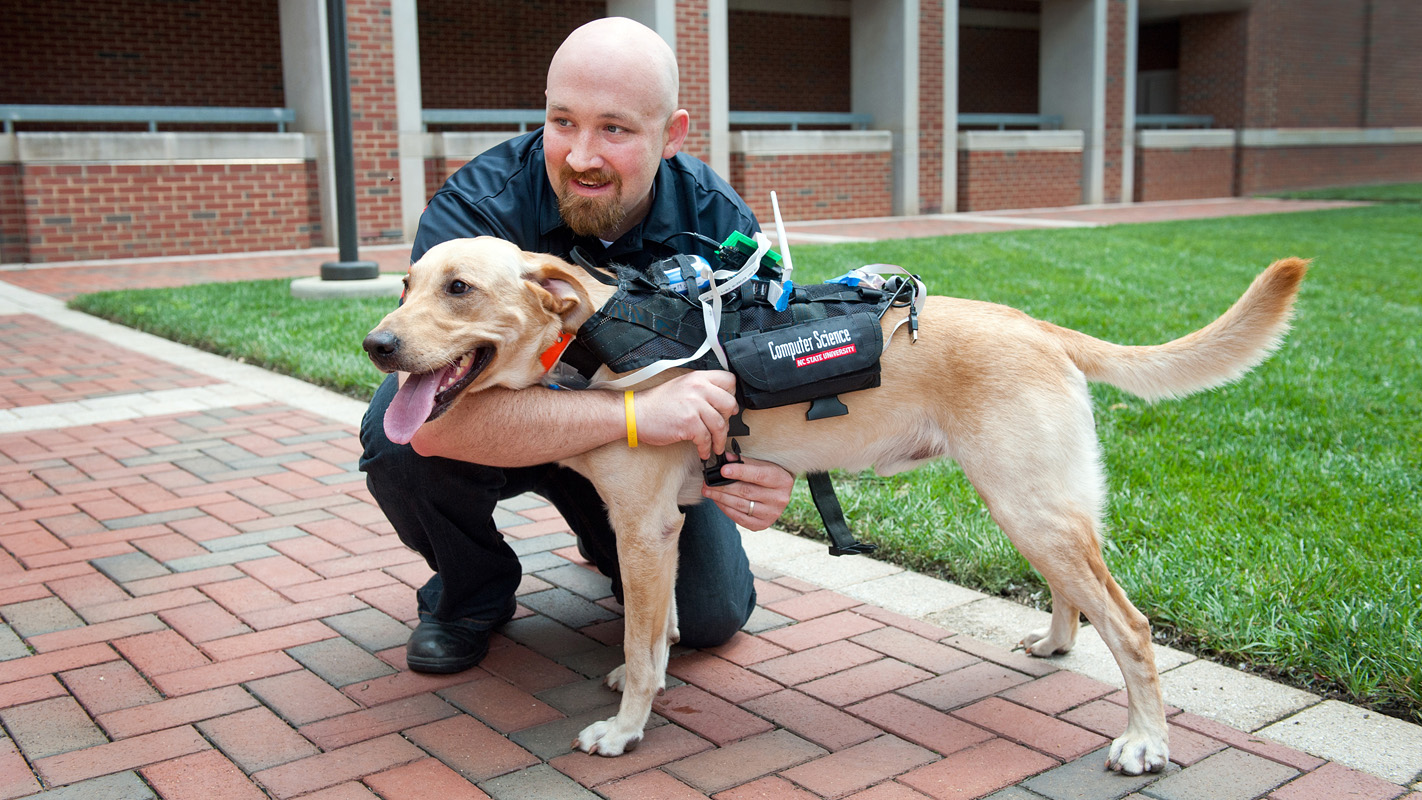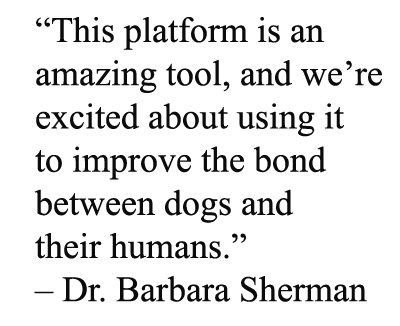New Tech Aims to Improve Communication Between Dogs and Humans

For Immediate Release
North Carolina State University researchers have developed a suite of technologies that can be used to enhance communication between dogs and humans, which has applications in everything from search and rescue to service dogs to training our pets.
“We’ve developed a platform for computer-mediated communication between humans and dogs that opens the door to new avenues for interpreting dogs’ behavioral signals and sending them clear and unambiguous cues in return,” says Dr. David Roberts, an assistant professor of computer science at NC State and co-lead author of a paper on the work. “We have a fully functional prototype, but we’ll be refining the design as we explore more and more applications for the platform.”
The platform itself is a harness that fits comfortably onto the dog, and which is equipped with a variety of technologies.
“There are two types of communication technologies,” says Dr. Alper Bozkurt, an assistant professor of electrical and computer engineering at NC State and co-lead author of a paper on the work. “One that allows us to communicate with the dogs, and one that allows them to communicate with us.”
“Dogs communicate primarily through body language, and one of our challenges was to develop sensors that tell us about their behavior by observing their posture remotely,” Roberts says. “So we can determine when they’re sitting, standing, running, etc., even when they’re out of sight – a harness-mounted computer the size of a deck of cards transmits those data wirelessly.
“At the same time, we’ve incorporated speakers and vibrating motors, called haptics, into the harness, which enable us to communicate with the dogs,” Roberts adds.
“We developed software to collect, interpret and communicate those data, and to translate human requests into signals on the harness,” says Rita Brugarolas, an NC State Ph.D. student and co-author of the paper.
 The technology also includes physiological sensors that monitor things like heart rate and body temperature. The sensors not only track a dog’s physical well-being, but can offer information on a dog’s emotional state, such as whether it is excited or stressed.
The technology also includes physiological sensors that monitor things like heart rate and body temperature. The sensors not only track a dog’s physical well-being, but can offer information on a dog’s emotional state, such as whether it is excited or stressed.
These technologies form the core of the platform, but it can be customized with additional devices depending on the specific application.
“For example, for search and rescue, we’ve added environmental sensors that can detect hazards such as gas leaks, as well as a camera and microphone for collecting additional information,” Bozkurt says.
“We’re also very interested in addressing stress in working dogs, such as guide dogs for the blind,” says Sean Mealin, an NC State Ph.D. student and co-author of the paper. “We’re reliant on the physiological and behavioral sensors to give us a picture of the dog’s mental and emotional state.
“This can help handlers identify and mitigate stress for the dogs, improving the length and quality of a dog’s life,” Mealin adds. “It’s an important issue. Particularly because guide dogs are bred and trained not to display signs of stress in their behavior.”
In addition to disaster response research, the research team has already done work that uses the platform to assist in dog training. They are now in the early stages of miniaturizing the technologies and improving the physiological sensors for use in animal shelters and hospitals.
“This platform is an amazing tool, and we’re excited about using it to improve the bond between dogs and their humans,” says Dr. Barbara Sherman, a clinical professor of animal behavior at the NC State College of Veterinary Medicine and co-author of the paper.
The paper, “Towards Cyber-Enhanced Working Dogs for Search and Rescue,” is published online in IEEE Intelligent Systems. The paper was co-authored by NC State Ph.D. students John Majikes and Robert Loftin, and by former NC State Ph.D. student Dr. Pu Yang. The work was supported by the National Science Foundation under Cyber Physical System Program grant number 1329738.
–shipman–
Note to Editors: The study abstract follows.
“Towards Cyber-Enhanced Working Dogs for Search and Rescue”
Authors: Alper Bozkurt, David L. Roberts, Barbara L. Sherman, Rita Brugarolas, Sean Mealin, John Majikes, Pu Yang, and Robert Loftin, North Carolina State University
Published: online October 29 in IEEE Intelligent Systems
DOI: 10.1109/MIS.2014.77
Abstract: We introduce the fundamental building blocks for a cyber-enabled computer-mediated communication platform to connect human and canine intelligence to achieve a new generation of Cyber-Enhanced Working Dog (CEWD). The use of monitoring technologies provides handlers with real-time information about the behavior and emotional state of their CEWDs, and the environments they are working in for a more intelligent canine-human collaboration. From handler to dog, haptic feedback and auditory cues are integrated to provide remote command and feedback delivery. From dog to handler, multiple inertial measurement units strategically located on a harness are used to accurately detect posture and behavior, and concurrent non-invasive photoplethysmogram and electrocardiogram for physiological monitoring. We also discuss how CEWDs would be incorporated with a variety of other robotic and autonomous technologies to create next generation intelligent emergency response systems. Using cyberphysical systems to supplement and augment the two-way information exchange between human handlers and dogs would amplify the remarkable sensory capacities of search-and-rescue dogs to let them save more lives.
- Categories:


